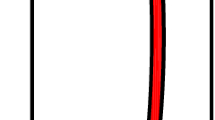Abstract
Two secant type methods are proposed for solving systems of nonlinear equations with a symmetrical Jacobi matrix. Quasi-Newton shift formulas of rank 2 are used. Stability and superlinear convergence are proved.
Similar content being viewed by others
Literature Cited
B. N. Pshenichnyi, “Newton's method for solving systems of equalities and inequalities,” Mat. Zametki,8, No. 5 635–640 (1970).
O. P. Burdakov, “Some globally convergent modifications of Newton's method for solving systems of nonlinear equations,” Dokl. Akad. Nauk SSSR,254, No. 3, 521–523 (1980).
J. E. Dennis and R. B. Schnabel, Numerical Methods for Unconstrained Optimization and Nonlinear Equations, Prentice-Hall, Engelwood Cliffs, NJ (1983).
L. Bittner, “Eine verallgemeinerung des Secantenverfahrens zur naherungsweisen Berechnung der Nulstellen eines nichtlinearen Gleichungssystems,” Wiss. Z. Techn. Univ. Dresden,9, 325–329 (1959).
P. Wolfe, “The secant method for simultaneous nonlinear equations,” Comm. ACM,2, No. 12, 12–13 (1959).
J. Ortega and W. Rheinboldt, Iterative Solution of Nonlinear Equations in Several Variables, New York, Academic Press (1970).
W. C. Rheinboldt, Methods for Solving Systems of Nonlinear Equations, SIAM, Philadelphia (1974).
H. Schwetlick, Numerische Losung nichtlinearen Gleichungen, Deutsche Verlag Wiss., Berlin (1979).
S. S. Lavrov, “Application of barycentric coordinates for solving some computational problems,” Zh. Vychisl. Mat. Mat. Fiz.,4, No. 5, 905–911 (1964).
Yu. M. Danilin and B. N. Pshenichnyi, “On minimization methods with accelerated convergence,” Zh. Vychisl. Mat. Mat. Fiz.,10, No. 6, 1341–1354 (1970).
Yu. M. Danilin, “On one class of minimization algorithms with superlinear convergence,” Zh. Vychisl. Mat. Mat. Fiz.,14, No. 4, 598–609 (1974).
V. I. Meleshko, “Investigation of algorithms with recovery of Hessian from gradient values,” Kibernetika, No. 5, 91–99 (1977).
O. P. Burdakov, “Methods of the secant type for systems of equations with symmetric Jacobian matrix,” Numer. Funct. Anal. Optim.,6, No. 2, 183–195 (1983).
O. P. Burdakov, “Stabilization of the secant method via quasi-Newton approach,” System Modeling and Optimization, Springer, Berlin (1986), pp. 141–152.
D. M. Gay and R. Schnabel, “Solving systems of nonlinear equations by Broyden's method with projected updates,” Nonlinear Programming 3, Academic Press, New York (1978), pp. 254–281.
O. P. Burdakov, “Stable variants of the secant method for solving systems of equations,” Zh. Vychisl. Mat. Mat. Fiz.,23, No. 5, 1027–1040 (1983).
O. P. Burdakov, “On superlinear convergence of stable variants of the secant method,” Z. Angew. Math. Mech.,66, No. 12, 615–622 (1986).
H. Schwetlick, “Uber die Realisierung und Konvergenz von Mehrschrittverfahren zur iterativen Losung nichtlinearen Gleichungen,” Z. Angew. Math. Mech.,54, 479–493 (1974).
W. B. Gragg and C. W. Stewart, “A stable variant of the secant method for solving nonlinear equations”, SIAM J. Numer. Anal.,13, No. 6, 889–903 (1976).
J. M. Martinez, “Three new algorithms based on the sequential secant method,” BIT,19, No. 2, 236–243 (1979).
J. M. Martinez and T. L. Lopes, “Combination of the sequential secant method and Broyden's method with projected updates,” Computing,25, No. 4, 379–386 (1980).
J. E. Dennis and J. J. More, “Quasi-Newton methods, motivation and theory,” SIAM Rev.,19, No. 1, 46–89 (1977).
F. R. Gantmakher, Matrix Theory [in Russian], Nauka, Moscow (1988).
J. R. Rise, “Experiments with Gram-Schmidt orthogonalization,” Math. Comput.,20, 325–328 (1966).
V. V. Voevodin, Computational Principles of Linear Algebra [in Russian], Nauka, Moscow (1977).
W. Hoffman, “Iterative algorithms for Gram-Schmidt orthogonalization,” Report No. 87-22, Univ. of Amsterdam, Dept. of Math., Amsterdam (1987).
O. P. Burdakov, “Globally convergent quasi-Newton methods,” in: Methods of Mathematical Programming and Software [in Russian], UrO Akad. Nauk SSSR, Sverdlovsk (1989), pp. 29–30.
Additional information
Translated from Kibernetika, No. 3, pp. 62–66, May–June, 1991.
Rights and permissions
About this article
Cite this article
Burdakov, O.P. Stable symmetric secant methods with restart. Cybern Syst Anal 27, 390–396 (1991). https://doi.org/10.1007/BF01068319
Received:
Issue Date:
DOI: https://doi.org/10.1007/BF01068319



